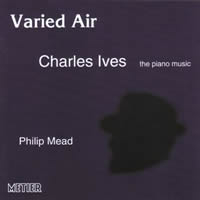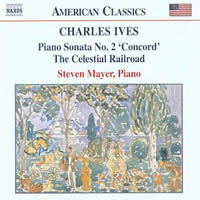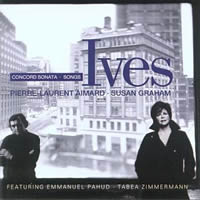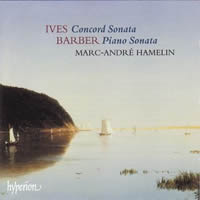Transcendentalist Studies: Aimard, Hamelin, Mayer, Mead Tackle Ives’ Concord Sonata
|
Grant Chu Covell [November 2004.] “These prefatory essays were written by the composer for those who can’t stand his music — and the music for those who can’t stand his essays; to those who can’t stand either, the whole is respectfully dedicated.” Concord, Massachusetts lies but a few miles from where I live and work. Removed from Greater Boston’s sprawl, Concord offers a fine balance of town and country — if you can afford it. Years ago I visited the Alcott and Emerson House museums. I parked at the side of the road, paid the admission, and scrutinized furniture and wall plaques (away from home, a sport we New Englanders also play). If you plan to come by, do it in the off-season. The town is a lot less charming when busloads of tourists disgorge. But you’ll still have to watch out for soccer-moms’ SUVs. Made famous by Thoreau, Walden Pond is a revered swimming hole, celebrated today for its crowds and the speed at which park rangers close the filled-to-capacity parking lot. You can hike ’round the pond to see the location of Thoreau’s humble shack — and pick up an empty soda can or cigarette butt to take home as a souvenir. Few know that Thoreau, heir to a successful pencil-making business, built his retreat in plain view of a thoroughfare, romanticizing his back-to-nature posture from its inception. Charles Ives’ take on the Transcendentalists and their town is more idealistic — but don’t take a jaded Eastern Mass. resident’s word for it:
Ives’ Essays are long and labored. This is where the composer proclaimed, among other things, “My God! What has sound got to do with music!” Ives’ Transcendentalist perspective was quirky. He adopted only those tenets and characteristics which suited him. The music never was easy, nor is it now. Prompted by the 50th anniversary of Ives’ death, a bumper crop of his most ambitious piano work is upon us. Ives studies have become serious business. Research and analyses replace the mid-20th-century’s raves. We now take into account Ives’ 19th-century Germanic roots. Ives did indeed foreshadow simultaneous rhythms, polytonality, microtonality and other contemporary trends, but he also stood shoulder to shoulder with Chadwick and Paine and doesn’t look all that out of place next to Brahms and Dvorak. Analyses of paper and drafts put the sonata’s creation at 1915-19, not 1911-15 as previously thought. Ives distilled the sonata from older, incomplete works, including large-scale compositions inspired by Emerson, Hawthorne and the Alcott family. (A reconstructed Emerson Concerto is on Naxos 8.559175.) Ives self-published the essays and sonata in 1921. The seeds of change were sewn. A scattering of other Ives publications (114 Songs and items in Henry Cowell’s New Music Quarterly) and performances over the next two decades, including Nicolas Slonimsky’s 1931 premiere of Three Places in New England, set the stage for John Kirkpatrick’s official premiere of the entire sonata at Town Hall, New York City, on January 20, 1939. The sonata’s second edition, ready in 1941, was not published until 1947, the year Ives won the Pulitzer Prize for his Third Symphony. From the year of its publication, the sonata has infuriated as much as it intrigues. Many have attacked the music’s impracticality and presumptuousness. It is, in fact, a monster on the page. Ives distributed samples marked “Complimentary: copies are not to be sold,” prompting a Musical America zinger: “At last a composer who realizes the unsalable quality of his music.” The sonata batters pianists and listeners alike with its mix of acid dissonances and homespun tonality. A wag remarked the irony that something so rich in discord should be called “Concord.” Unbarred measures predominate, but even in relatively regular moments, Ives will toss in a 7/8 or a 4 ½ / 4. There’s also the famous 14 ¾-inch piece of wood needed to play arm’s-length clusters. And why does a piano sonata have parts for viola and flute? The legend that the composer went back to tweak dissonances persists to this day, though the evidence indicates Ives had been harvesting dissonances from his pre-1915 sources. The composer suggested that sections of his Second Quartet can be heard as four men arguing. The piano trio is alive with the exuberance of college life. You have to hear the solo-piano music similarly — folks expressing strong opinions. The sonata’s four movements relate to Concord’s famous residents: Ralph Waldo Emerson, Nathaniel Hawthorne, the Alcott family (including Bronson and daughter Louisa May), and Henry David Thoreau. The tempestuous “Emerson” movement is the most difficult of the four, the philosopher’s spirit in miniature. Looking past the Beethoven’s-Fifth quotations and hymns, Ives’ knotty harmonies and irreverent tonality suggest Berg’s Op. 1. The frenetic, scherzo-like “Hawthorne” movement represents moods and characters from the author’s short stories: “… [T]his … is supposed to be played as fast as possible and not too literally.” Even with its grand climax, “The Alcotts” behaves like a slow movement, a stately centered oasis. “Thoreau” is the contemplative finale, bringing together the sonata’s themes and dissolving into a slow fade of Walden Pond’s famous resident playing his flute. Ives never applied “sonata” to his works lightly. (There are two for piano, four for violin and piano.) George Ives taught his son well, and the younger Ives’ Yale studies also helped. Ives would likely have welcomed a comparison of his stretching of form to Beethoven’s; the work is decidedly ambitious and symphonic. Another American maverick, Henry Brant, labored at an orchestration between 1958 and ’94. Brant’s 50-minute Concord Symphony premiered in 1996. “… without any doubt the most startling conglomeration of meaningless notes that we have ever seen engraved on white paper….” While Ives’ generous use of familiar tunes suggests collage or possibly even pastiche, close study reveals that he worked his borrowings hard, developing motives and cells much like his contemporaries Bartók and Schoenberg. The first four notes of Beethoven’s Fifth figure prominently and wildly. They’re frequently reduced to three repeated notes followed by a skip. We hear them within the hymn Martyn, softened with textbook harmonies, at “The Alcotts”’s opening. Listen closely and you’ll hear fate knocking throughout. Several passages in “Hawthorne” and “Thoreau” hint at Debussy, whose work the composer knew. Ives probably wanted to leave the sonata unfinished. When he played it for himself, he altered the music to suit his mood. “A metronome cannot measure Emerson’s mind and oversoul, any more than the old Concord Steeple Bell could.” Themes rarely appear the same way twice. Ives took his time preparing the work for release, frustrating his publisher with last-minute changes. The 1920s Transcriptions from “Emerson” series captures further explorations. Later came The Celestial Railroad, a reconsideration of “Hawthorne,” which Ives would fold into the Fourth Symphony. We’re fortunate to have Ives’ own recordings in which he blithely strays from the page. When Kirkpatrick visited for advice, the composer showed little interest in coaching. “His supposition was that if your heart was in the right place, and if you were really devoted in an idealistic way to the music itself, anything you did would have a certain validity, comparable to the validity of what he himself would do in the situation.” Consequently, pianists sometimes deviate from the score. What if Ives had turned to Mallarmé instead of the Transcendentalists? Might he have anticipated Boulez’s Third Sonata? Or is Boulez somehow Ives’ descendant? For a comprehensive dive, you’ll want the score (2nd ed., AMP), Essays before a Sonata (reprinted in Dover Publications’ Three Classics in the Aesthetic of Music or here), Geoffrey Block’s Ives: Concord Sonata (Cambridge University Press), Kirkpatrick’s edition of Ives’ Memos (W.W. Norton), and Vivian Perlis’ Charles Ives Remembered (University of Illinois). AMP offers Ives’ annotations, excerpts from the Essays, and selected 1920s press quotes. Any serious Ivesian has to hear the insurance executive’s idiosyncratic playing in four recorded sessions between 1933 and 1943 (CRI 810’s expansion of tracks from Columbia M4 32504). He starts and stops, groans and exclaims. Recorded April 24, 1943, at age 68, Ives plays “The Alcotts” hastily. Strange to say, he restrikes tied notes. On that same day, three takes of They are There! preserve the composer’s unlovely vocalizing over energetic playing. With John Geist’s help, the Kronos Quartet devised a setting with which they could play along (Nonesuch H 979242-2). I don’t believe Kirkpatrick’s LPs ever made it to CD. Gilbert Kalish’s 1976 analogue recording, reissued on Nonesuch 71337-2 (with John Graham, viola, and Samuel Baron, flute), has aged well, despite traces of overload. On Easley Blackwood’s 1991 Cedille 900000 005 release (with Richard Graef, flute), filled out with the Copland Sonata, a thin, malnourished acoustic blunts Blackwood’s subtleties. Robert Shannon’s recordings on Bridge include a critically acclaimed set of the four violin sonatas with Gregory Fulkerson (BCD 9024A/B), along with Ives’ Second Sonata paired with John Harbison’s First (BCD 9036). Shannon’s intelligent and vigorous Concord reflects the music’s elemental mystery. A sonorous thud in “Hawthorne” reminds us of the work’s physical requirements. “The Alcotts” is perfect. James Hepokoski’s superior program notes, linking Ives with the 19th-century German tradition, touch on the Yalie’s nostalgic yearnings. “… the greatest music composed by an American.…”
Philip Mead (piano), Elena Artemonova (viola), Helen Brammen (flute). 2 CDs include Piano Sonata No. 1 (1902-10), Three-Page Sonata (1905), Study No. 2, “Varied Air and Variations” (ca. 1923), Study No. 9, “The Anti-Abolitionist Riots in the 1830s and 1840s” (ca. 1908-09), Study No. 20, “Even durations – unevenly divided” (ca. 1908), Study No. 21, “Some South-Paw Pitching!” (ca. 1909), Study No. 23, “Baseball Take-Off” (ca. 1909), Five Take-Offs (1906-07) and Waltz-Rondo (ca. 1911). Metier MSV CD92037. Recorded June 29, 1999, January 30 and April 9, 2000. For this impressive two-CD set, Mead plays a Steinway Model C, a smaller and tighter-sounding instrument than the concert Steinway D. Mead and producer David Lefeber intended to suggest an instrument Ives might have used. The piano’s reduced resonance probably accounts for Mead’s brisk speeds and pinched dynamics. It takes a few moments to adjust to the shift in scale. The Metier conjures a lonely musician improvising in a deserted town hall rather than a tuxedoed pianist onstage. In “Emerson” (misspelled on Metier’s track listing), the 7/8 section (page 8) momentarily hints at Messiaen. It’s easy to miss the viola’s two sotto voce measures. Mead tears through “Hawthorne” deliriously. The tight piano shrouds Ives’ wonderful effects: sustained chords emerging from the din and ppp chorales following ffff salvos. In a hurried “The Alcotts,” the scent of lilacs blows too quickly through the town. Mead works wonders with the gauzy “Thoreau,” the A-C-G ostinato becoming Mahlerian. But the harsh, too-prominent flute doesn’t blend into the fog. If Mead had chosen a Steinway D, he’d move to the head of the class. Ironically, the Model C’s minimal reverberation reveals Mead’s astounding accuracy. I like what Mead has to say, but wish I could hear it better. The massive Concord is less than half of Mead’s menu. The first sonata, Studies and short pieces speak to Mead’s dedication. Ives’ intensely personal piano works could reflect political views (Study No. 9, “The Anti-Abolitionist Riots in the 1830s and 1840s”) or favorite pastimes (Study No. 23, “Baseball Take-Off”). The Three-Page Sonata is a potent statement comparable to Bartók, Schoenberg, or Scriabin’s inquiries into short forms. The acoustics confirm three different recording venues.
Steven Mayer (piano); neither viola nor flute; Kerry Shale recites Emerson, Thoreau and Ives before each sonata movement. Includes Varied Air and Variations (ca. 1923), The Celestial Railroad (ca. 1924-5) and Transcriptions from “Emerson,” No. 1 (ca. 1922-23). Naxos 8.559221. Recorded January 30-31, 2002. I dreaded the spoken aspect. While they’re appropriate enough, Emerson and Thoreau’s words grow tiresome, their well-meaning convolutions especially patronizing. Surprisingly, Ives’ quotes have a reassuring, grandfatherly quality. Mayer exudes a relaxed confidence. This is a good introduction; however, the Concord’s depths are beyond his reach. “Hawthorne” never achieves its frantic jubilation. Mayer seems lost, unable to grasp the 12:14 movement’s form or force. He introduces “overtone echoes” on page 34, corresponding to similar notes in The Celestial Railroad and the Fourth Symphony. Despite momentary lingering, the beauty of “The Alcotts” barely surfaces, and there’s a small recording or post-production glitch at 4:38. I miss “Thoreau”’s flute. To his credit, Mayer programs other pieces related to Concord and its material: Transcriptions from “Emerson,” No. 1 and The Celestial Railroad, which Mayer plays more convincingly than its antecedent “Hawthorne.” Mayer’s Varied Air and Variations spreads to 7:33 compared against Mead’s more efficient 5:29. Ives never talks down to his listeners, imagined or ideal. This study, cheekily written for uncomprehending ears, arranges several atonal variations on an awkward string of notes. The episodic Varied Air can be baffling. Mayer flounders, but Mead gets it — it’s his set’s title, in fact.
Pierre-Laurent Aimard (piano), Tabea Zimmermann (viola), Emmanuel Pahud (flute); mezzo-soprano Susan Graham joins Aimard in 17 Ives songs. Warner Classics 2564 60297-2. Recorded November 6-8, 2003 (songs), January 7-10, 2004 (sonata). Seventeen songs with mezzo-soprano Susan Graham precede Concord, including the very approachable — and to Ives fans familiar — Ann Street (“rather short”), The Cage, Memories (A – Very pleasant, B – Rather sad), The Housatonic at Stockbridge and The Things Our Fathers Loved. The set ends with Thoreau, foreshadowing the sonata’s philosophical and musical themes. Graham and Aimard are perfectly matched, their ideally intertwined balance perhaps owing to studio sleight-of-hand. However, I wouldn’t want to slight Jan DeGaetani and Gilbert Kalish’s classic Ives song recording (Nonesuch H 971325-2). When Aimard solos in the sonata, we get luxuriant sound with vivid details. His slowing in “Emerson” directs a light at Ives’ crags and caverns. Elsewhere his relaxed pace can seem too deliberate, yet he plays incredibly precisely, emphasizing melodies in Ives’ filigree. What else would you expect from someone who can play Ligeti’s Etudes fluently? Where you sense other pianists winking when they play the borrowings, Aimard courses through “Hawthorne” pragmatically, bestowing equal importance to dissonance and hymns. He also adds “overtone echoes” to page 34’s chorale. The ragtime bits are crisp. He delicately applies the “strip of board,” ever so slightly rolling the clusters. The section shines. The approach to the climax in “The Alcotts” is staged plateau upon plateau, rather than as a headlong rush to the peak. “Thoreau”’s fog is denser than most. The extra instruments add just the right touch.
Marc-André Hamelin (piano), Jaime Martin (flute); no viola. Paired with Samuel Barber’s Piano Sonata, Op. 26. Hyperion CDA67469. Recorded April 5-6, 2004. This is a wonderfully mischievous pairing: Barber couldn’t stand Ives. Hyperion curiously identifies the Sonata as Ives’ Op. 19. (This is Hamelin’s second Concord recording; the first, exuberant but less explorative, was released in 1989 on New World Records 378-2, where it’s paired with Maurice Wright’s 1982 Sonata.) Hamelin whirls through Ives as if he’d like to get back to Godowsky. “Emerson” is wonderfully manic, alternating poetry with brute force. Fast-paced “Hawthorne” is capricious, as if Hamelin plays it daily, after dinner. He exposes Debussyesque touches. The pianist gently highlights the improbable “here comes the bride” quote from Wagner’s Lohengrin, skips page 34’s overtone echoes, but adds a crunching cluster (page 35, third system, first measure, fourth beat — he also did this in 1988). With Hamelin pedaling through rests, “The Alcotts” feels hurried. The pianist doesn’t employ “Emerson”’s optional violist. The booklet explains why he plays the line himself, but it’s not there. “Thoreau”’s coarse and jarring flute sounds like an afterthought. He took it alone in the earlier recording. Barber’s sonata is small-minded and dull by comparison. Hamelin shapes it well enough, but the material lacks staying power. While Concord is orchestral in its scope, it remains a pianist’s work, unlike the Barber, which sounds unfit for piano keys. The Copland sonata would have been preferable, or a rematch with the unknown Wright. I would have preferred Berg’s Op. 1 or Schoenberg’s Opp. 11 and 19. Even Scelsi would be a better complement than the limp Barber. Ives: Piano Sonata No. 2, “Concord, Mass.”
Given Concord’s malleability, it’s hard to imagine owning just one recording. Whether you require the optional instruments or care how the sonata is paired will determine which release should occupy your shelf. Any of the above will enrich the newcomer. The songs, a crash course in Ives’ styles, sway the balance to Aimard’s release with both optional instruments. As middle-of-the-road and purely piano as Mayer’s disc is, I like having The Celestial Railroad. The Naxos’ attractive price is an added inducement. Mead’s two-CD set is a comprehensive survey, recalling Herbert Henck’s earnest Wergo series, but even when spiced with viola and flute, Concord deserves a big instrument. However, the Studies are hard to come by and Mead knows his way around them. His set will appeal to more than completists and scholars. While valued experience guides Hamelin, I don’t need the Barber sonata. Aimard and Hamelin’s star status will undoubtedly pull in audiences. If you want to hear Concord and can’t play it yourself, you need to find someone who will bring the whole world to it and wrestle it down to size. Looking at it another way, Mayer seems naïve, Hamelin the enlightened, Mead the autodidact, and Aimard the cosmopolitan. It may be the speaker, but it’s hard to imagine Mayer handling the whole thing in concert. Hamelin, Mead and Aimard take center stage. Despite Mead’s quirky instrument, his well-thought-out approach makes for an excellent alternate. He’s the one with whom I would most want to talk about the Sonata. Ives’ songs outclass Barber’s sonata, and Warner’s vibrancy trumps Hyperion’s fuzziness. Aimard emerges a winner even though Hamelin’s is the more traditional, albeit hurried, reading. And let’s not forget that Shannon’s is among the best of the older releases. I’ve listened to Concord over three dozen times while working this piece. On many days I wasn’t up to confronting Ives’ rich but difficult music. Sometimes the perfectly proportioned “The Alcotts” was all I could handle. There’s a whole world in Ives’ masterpiece, an entire philosophy cast in four tableaux, comparable to Mozart’s Don Giovanni or Mahler’s Ninth. I can see why Brant was compelled to orchestrate it and why Hamelin felt impelled to re-record. “Part of Ives’ point of view toward performance was derived from Emerson. He wanted to make music that would be good for the players’ souls. It was a little bit as if he said to them, ‘This may hurt, but it will be good for you.’”
[More Grant Chu Covell, Piano Factory]
[More
Ives]
[Previous Article:
Alex Ross Among the Germans]
[Next Article:
Wagner’s Ring Tones]
|



